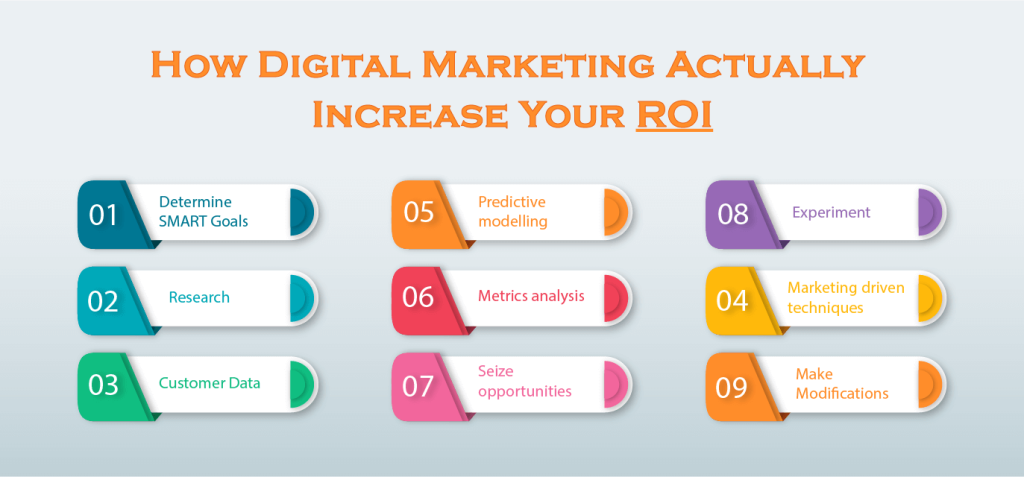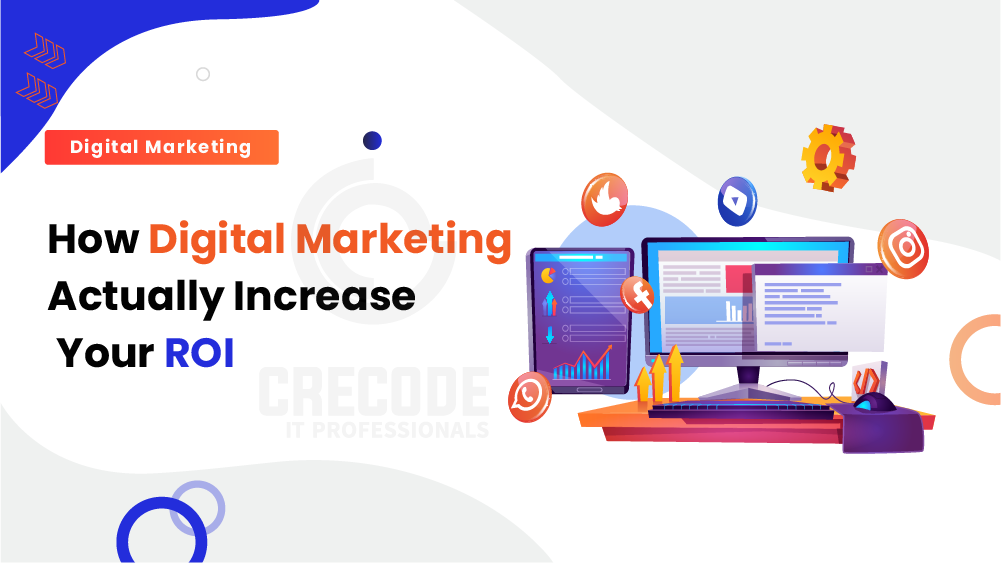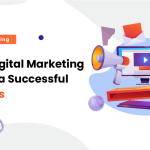Bonjour, folks! What brought you here? You’re undoubtedly interested in learning better about how to boost ROI with digital marketing.
I would like to commence with a definition of digital marketing. Whether you manage a brand, run a business, or are a brand yourself, everyone requires digital marketing services to sell their products or services in today’s digital environment.
You can encounter a more general audience, allowing you to do more than simply sell. It might be formidable to boost your business without a powerful online existence.
One of the most important explanations why digital marketing has become so substantial is the capability to communicate with potential and current customers, respond to concerns, and resolve issues.
Digital marketing is paramount because it conjoins a company with its customers while they are online, and it works in any endeavor. It connects businesses with prospective customers on Google via SEO and PPC, social media via social media marketing, and email via email marketing.
So, what exactly is the ROI that we’re going to talk about?
In the realm of marketing, The term “return on investment” refers to the method of measuring a company’s marketing return on investment (ROI). It’s also known by its abbreviation, MROI, or return on marketing investment, according to Avery.
Businesses and companies all around the world devour a lot of finances on online marketing in a directive to achieve their supreme goal: to maximize returns.
Businesses consider the Return on Investment (ROI) while contemplating whether or not to continue marketing efforts. You, too, as a business owner, have financed online marketing in the expectancies of achieving a lofty return on investment and success.
When I talk about ROI, I don’t mean just scanning numbers; I convey a method that allows marketers to fetch noteworthy insights into the absolute success and profitability of their marketing campaigns.
Now that you understand what we're proceeding to talk about, let's get into the nitty-gritty of how to boost ROI with digital marketing.

Determine what you want to achieve
Settling on a return on investment goal is no different, although it might be difficult to determine. When you set business goals, you consider a number of elements that could influence your road to success.
Make “SMART” goals, which are specific, measurable, achievable, relevant, and time-bound. This strategy could help you finagle your direction to reaching your goals and keep track of your progress.
Keep in mind that a variety of factors influence your marketing ROI, including cost structure, industry, and market demand. The campaign you run has an impact on your ROI. For example, the ROI of an SEO campaign will differ from that of a PPC campaign.
It’s critical to clearly describe the objective of your marketing tactics when materializing campaign goals. It’s also critical that you only create goals that are achievable.
Setting unreasonable goals for your marketing team or projects might have a significant mark on your overall approach.
The miracles of Customer Data
Better understanding the worth of the information you compile is the first action toward determining how to reckon and plan digital marketing with it.
Regardless, when it comes to digital marketing, many companies underused analytics.
According to Forbes research, just half of the marketers use data-driven marketing to customize marketing messages and offers, and just 39% of businesses gain from making decisions based on customer data.
Only 3% of firm executives consider demonstrating the success of marketing to be a major concern.
Given the amount of data piled in a single minute, these statistics are startling, and they contradict the conclusion that personalized marketing is a primary concern for 92 percent of executives, according to the same study.
Marketing driven techniques
It’s really no surprise that today’s digital technology allows marketers to delve deeper than ever before into consumer data, not only for prospecting but also for ongoing customer interaction.
As an upshot, forward-thinking executives across the company promote data-driven processes that spotlight marketing principles across the selling process.
These efforts will assist to support the emergence of customized service, which many regards as a trademark of tomorrow’s marketing-driven businesses, rather than the outmoded concept that marketing is a fancy sidequest.
Predictive modelling is a great way to go
Predictive analysis can help you calculate and improve your return on investment and do socially better.
These analytical tools, which were formerly used primarily to anticipate conversions or sales before launching a marketing campaign, now allow marketers to analyze specific metadata about individuals and businesses utilizing the internal, website, and social data.
As a result, based on these insights, successful marketing campaigns can be devised.
Keep an eye out for Metrics
See the metrics that are overrated (or underrated). Some metrics, particularly those related to social media, are exaggerated.
Though Facebook’s likes and shares are easy to track, they have minimal impact on income.
It’s also oversight to rescind them completely, because likes, shares, and comments can help your brand rank higher in Google and other search engines, resulting in additional traffic.
This is extremely accurate for those who have to lean on non-traditional metrics to figure out which elements charm their achievement.
You may also promote your goods or services within that content. You’ll have a higher possibility of turning your investment into revenue if you know the ABCs of sponsored advertising.
Seize this opportunity & make necessary modifications
Identify and seize opportunities early. You must understand that data will be the foundation of your future strategy.
It’s a waste to have a lot of data but not use it to deepen the relationship with the information that customers have entrusted to us.
Taking advantage of the opportunities will yield incredible results, not only in terms of sales, but also in terms of click-through rates, engagement rates, and post-purchase behavior.
Above all, Experiment and Make Changes. By interpreting data and monitoring trends with analytics, your company can unlock possibilities, remove roadblocks, and bring beneficial attention to your brand.
Marketing strategies that connect and thrill users, attract and keep consumers, and expedite marketing ROI can be developed as knowledge is exploited.
Takeaways
Digital marketing return on investment is a critical business indicator that should not be overlooked. From social media and email lists to paid commercials and in-depth search engine optimization, there is an assortment of online marketing avenues available.
Companies must use these channels and take the necessary steps to maintain an optimal return on investment in order to perpetuate the invariant transition.
As a general guideline, digital marketers should strive for a 5:1 return on investment (ROI), or $5 for every $1 invested on a marketing campaign.
In case this does not meet your expectations, raise it a notch! A marketing ROI of 10:1 or overhead is deemed as exceptional. This goal will very undoubtedly necessitate more resources and proficiency, but it is nevertheless doable.
On the other flank, an ROI of less than 2:1 is unprofitable and demonstrates that your marketing strategy requires refinement.
Crecode is delighted to oblige you in maximizing your digital marketing ROI. We’re a digital marketing agency with years of expertise executing endeavors.
Connect with our team of professionals today to witness how we can assist you with your digital marketing plan.


